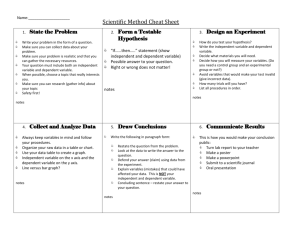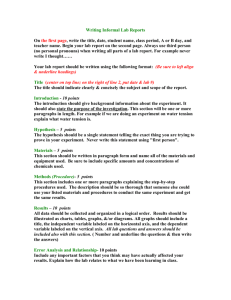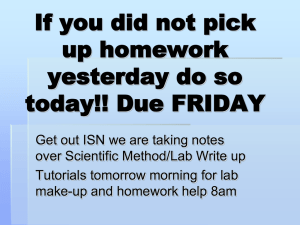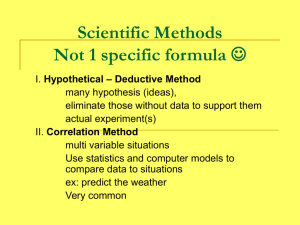Background Information
advertisement
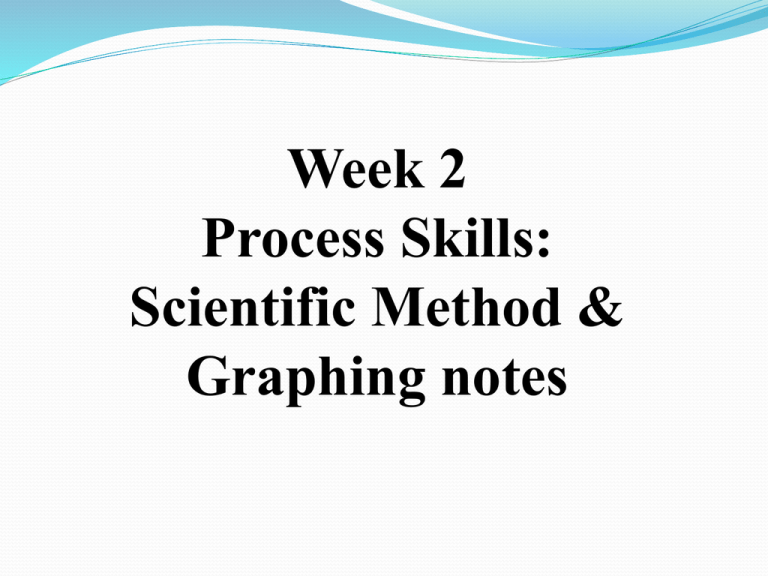
Week 2 Process Skills: Scientific Method & Graphing notes What are the steps of the scientific method? 1. Background Information 2. Problem 3. Hypothesis 4. Materials 5. Procedure 6. Data 7. Conclusion Let’s talk about them one at a time! Background Information Background information is information that you research before you conduct your investigation. It might be information you already know! This information helps you clearly understand your topic before you begin conducting experiments. This might include safety information! Example: If you were doing an experiment with M&M’s, would you have any Background information? Sure you would! 1. What colors do they come in? 2. What types of M&M’s are there? What else can you come up with about M&M’s? You see, you are already very smart! Problem A problem is the question you (the scientist) plan to answer by conducting the scientific investigation. Think of this problem about Open House? Problem: What will happen if your parents come to open house? A Problem is always stated as a question. It is the question that you want to solve or answer during your scientific investigation. Hypothesis The hypothesis is an educated guess or explanation that answers the question in the problem. This is what you THINK the answer might be. A hypothesis should be written as an IF/THEN statement! Cause and effect When one thing happens it causes another thing to happen. Example: If I run in the hall, Then I will get hurt. Let’s Practice Write a hypothesis to the following problems: 1. What will happen if I don’t wear safety goggles in the lab? 2. What will happen if I don’t complete my homework? 3. How many drops of water can a penny hold? 4. If we fill a baby food jar with water, then how many drops of water will it take to cause the jar to overflow? Materials This is the list of supplies and equipment that you will need to prove whether or not your hypothesis is correct. Rules for listing materials 1. Be descriptive! (tell me the size, shape, color etc.) 2. Be precise! (Say 50ml of water and not a little bit of water) 3. Don’t forget what you will need to clean up! 4. If you need a liquid, you’ll need something to hold the liquid in. Procedure The list of steps that you will follow to prove whether or not your hypothesis was accepted or rejected. These will be numbered steps, in exactly the order that you will follow them. List each step separately and be as descriptive as possible. Data Needs to be displayed in charts or graphs with correct heading and titles AND NOW…. THE BIGGIE…. Conclusion Conclusion The Conclusion is the answer to the problem, that you discovered during your scientific investigation. The Conclusion has 5 parts… 1. The hypothesis was accepted/rejected. 2. It Stated… 3. To test the hypothesis… 4. During the test it was observed… 5. Therefore… You should practice writing more conclusions, we will be writing a lot of conclusions through out the school year. Great Job! Now let’s review. 1. List the 8 steps of the scientific method in order. 2. Which step of the scientific method is the questions that arise during the lab experiment? 3. Which step of the scientific method comes before procedure? Now let’s say the 8 steps of the scientific method all together! 1. Background Information 2. Problem 3. Hypothesis 4. Materials 5. Procedure 6. Data 7. Conclusion Congratulations! You are almost ready for the scientific method test! How to set up successful graphs in Science class! How to set up your graph! How to set up your graph! Y Axis (This is for your dependent variable) How to set up your graph! X Axis (This is for your independent variable) TAILS Teachers’s Favorite Singer T - Title TAILS Teachers’s Favorite Singer T - Title A - Axis Y Axis = Dependent Variable X Axis = Independent Variable TAILS Teachers’s Favorite Singer Decide on an appropriate scale for each axis. Choose a scale that lets you make the graph as large as possible for your paper and data T - Title A – Axis S – Scale How to determine scale Favorite Number of Singer Teachers Toby Keith 22 Madonna 15 Elvis 11 Sting 5 Sinatra 2 Scale is determined by your highest & lowest number. In this case your scale would be from 2 – 22. How to determine Intervals Favorite Number of Singer Teachers The interval is decided by your scale. Toby Keith In this case your scale 22 Madonna 15 Elvis 11 Sting 5 Sinatra 2 would be from 2 – 22 and you want the scale to fit the graph. The best interval would be to go by 5’s. TAILS Teachers’s Favorite Singer The amount of space between one number and the next or one type of data and the next on the graph. The interval is just as important as the scale T – Title A – Axis I – Interval Choose an interval that lets you make the graph as large as possible for your paper and data S – Scale TAILS Teachers’s Favorite Singer 25 T – Title 20 15 A – Axis 10 5 I – Interval 0 S – Scale TAILS Label your Y Axis. Teachers’s Favorite Singer Number of Teachers 25 T – Title 20 15 A – Axis 10 5 0 LABELSingers your bars orGive datathe bars a general pointslabel. What do those words I – Interval L – Labels S – Scale When to use… Bar graphs Used to show data that are not continuous. Allows us to compare data like amounts or frequency or categories Allow us to make generalizations about the data Help us see differences in data Line Graphs For continuous data useful for showing trends over time

